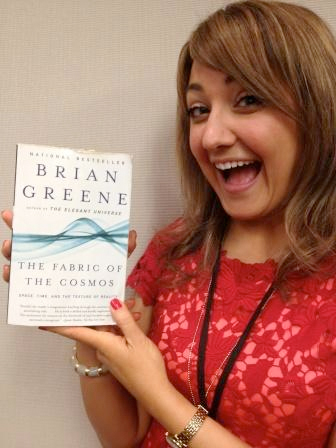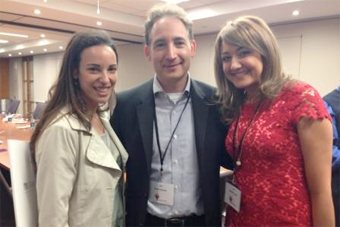“The planets have a beat,” said Dr. Oded Aharonson, snapping his fingers. Skyped in from Israel into a Manhattan boardroom on May 10, Aharonson is a scientist who has operated the rover on Mars. Some of his pictures of Titan are among those that have given us, on earth, a more accurate perspective on what it means to live in a solar system.
He held up a basketball, partly because he needed a round object to show the oscillations of the earth’s climate cycles and partly because the Tomorrow Lab Summit was being hosted by and is a community partner of NBA Cares. NBA Commissioner David Stern was one of the two men at the head of the table and the other was Marshall Levin, the President and CEO of the American Committee for the Weizmann Institute of Science, the organization that created the Tomorrow Lab project to support the mission of science for the benefit of humanity.
Every 20,000 years, Aharonson explained, earth’s orbit changes and summer occurs closer or further from the sun. Every 40,000 years or so, the poles point more toward the sun, which changes the climate of the planet. Every 100,000 years, the furthest point from the sun moves in and out. The glacial cycles are connected in this way to the beat of the planet’s movement, which is one of the reasons why we’ve had climate change on our planet in the past. But it isn’t the beat of that particular dance, he warned, that’s causing the massive global warming we’re experiencing today.

As a girl on spring break, Jennifer Lopez, shown here at the Tomorrow Lab Summit, loved reading Brian Greene while her friends flipped through fashion magazines. She later went on to study molecular biology and now, as a philanthropist, focuses on social entrepreneurship.(Image by Rita J. King)
I looked across the table at Jennifer Lopez, director of strategic partnerships at PopTech, who I’d met only a couple of weeks ago on April 23 after a talk I gave about the future of business at the intersection of science and art. We connected instantly, animated by our shared passion for getting girls excited about science and math. During a rapid-fire exchange we learned that we share a role as supporters of the Tomorrow Lab project. We agreed on the spot to start collaborating. She came to visit me at Science House a few days later to discuss ways we could prepare for the Tomorrow Lab Summit. When I told her Brian Greene would be there, her face lit up.
“On spring break,” she told me, “I was the one reading The Elegant Universe while my friends flipped through magazines. I love quasars!”
Science House founder James Jorasch and I first met with Marshall and his team a couple of years ago. We committed to Tomorrow Lab when we began to learn about the jaw-dropping accomplishments of the Weizmann Institute. The news coming out of Weizmann is always stunning, so we were happy to record videos of ourselves (here’s mine) telling stories about our passion for science and what it means to us. James’s video is about a memorable teacher who sparked his imagination. These videos become leaves on the tree of humanity that Tomorrow Lab aims to create, a repository of stories about the personal impact of science in our lives that others can support to keep the work at Weizmann going strong.
Each person at the Tomorrow Lab summit similarly described the passion that attracted them to the project. As I listened, I sensed a seismic shift in the future of the effort. Somehow, we managed to eat sandwiches while theoretical physicist Brian Greene reminded us of the underlying weirdness at the subatomic scale within the illusion we perceive as reality. Jennifer and I glanced at each other across the table and raised our eyebrows, a silent reminder of the promise we made to get a picture of ourselves with Brian Greene before the summit’s end.

In an infinite multiverse, theoretical physicist Brian Greene could have been anywhere on May 10, but he was at the Tomorrow Lab Summit with Rita J. King, left, and Jennifer Lopez, right. (Image by Tracy Day)
The more tangible proof of the power of science came when not one, but two people at the table shared stories about having survived brain tumors. Matthew Zachary, founder of Stupid Cancer, shared a glimpse of a terrifying moment in his life when, as a concert pianist and 21-year old college senior, he lost the use of his left hand, was diagnosed with a brain tumor and told that he might not survive. The group also included investors looking to channel significant resources into the future of science, publishers, strategists and editors of prominent publications looking to infuse their content for girls with the exciting presence of women they might want to emulate.
Allison Arden, publisher of AdvertisingAge and author of The Book of Doing, spoke about creativity and sending a pumpkin through the mail because she discovered that it was possible to do so. What else, she wondered, is possible?
It’s rare for a meeting to start with a mention of the shared beat of the planets and have the snap of a distant scientist’s fingers continue to keep silent time for two hours until the rhythm animates the people in the room. Tomorrow Lab has set a mission for us, and we are in service of that shared goal: to support science for the benefit of humanity, right here on the tiny blue planet that we share. We need all earthlings on board.
Click here for article.
